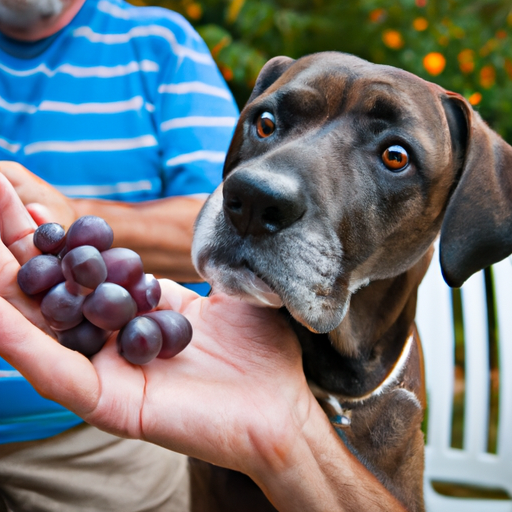Being a caregiver, it’s your duty to provide your furry friend with the utmost care and protection. In this detailed guide, we will walk you through a critical topic that every dog owner should be aware of: How many grapes are bad for dogs?
Understanding the Risk
It’s common knowledge that certain foods are dangerous for dogs, but you may be surprised to learn that grapes are among them. Even a small amount can cause serious health problems.
The exact substance in grapes that leads to toxicity in dogs is not yet known, but what is clear is the serious impact it can have on a dog’s health. Intake of grapes, in any quantity, can potentially lead to acute kidney failure in dogs.
Symptoms of Grape Toxicity in Dogs
If your dog has ingested grapes, it’s crucial to understand the symptoms they may exhibit. The earlier the signs are noticed, the sooner you can seek veterinary assistance.
- Vomiting or Diarrhea: This is usually one of the first signs of grape toxicity. The vomit or stool may contain pieces of grapes or raisins.
- Loss of Appetite: Your dog may suddenly lose interest in food.
- Lethargy: Dogs affected by grape toxicity often exhibit signs of weakness, sleepiness, or unusual quietness.
- Abdominal Pain: Your dog may show signs of discomfort or pain in the abdominal area.
- Increased Thirst and Urination: You may notice that your dog is drinking or urinating more than usual.
How Many Grapes Are Toxic
The toxicity of grapes varies from dog to dog. Some dogs may show signs of illness after ingesting just a single grape, while others may consume a handful without any immediate effects. Regardless, any grape intake should be considered serious and warrant immediate veterinary attention.
| Size of Dog | Potentially Lethal Grape Intake |
|---|---|
| Small Dogs | 3-4 Grapes |
| Medium Dogs | 7-10 Grapes |
| Large Dogs | 12-15 Grapes |
What to Do If Your Dog Eats Grapes
If you suspect your dog has eaten grapes, act quickly. Here’s what you can do:
- Remove any remaining grapes: Prevent your dog from consuming more grapes.
- Contact your vet immediately: Don’t wait for symptoms to appear.
- Induce vomiting if advised: Your vet might instruct you to induce vomiting. Do not attempt this without professional guidance.
- Prepare for potential hospitalization: In severe cases, your dog may require hospitalization for monitoring and treatment.
Prevention and Safety
As caregivers, the best way to protect our dogs from grape toxicity is by prevention.
- Keep grapes and raisins out of reach.
- Educate others in your home about the dangers of grapes.
- Monitor your dog during walks or outings.
Frequently Asked Questions
1. Can dogs eat grape-flavored foods or drinks?
It’s best to avoid any food or drink with grape flavoring. While the toxic substance may not be present in artificial grape flavoring, it’s better to be safe than sorry.
2. Can dogs eat grape seeds or grape skins?
No, all parts of the grape – the flesh, the skin, and the seeds – are considered toxic to dogs.
3. What other fruits are unsafe for dogs?
Apart from grapes, other fruits that are unsafe for dogs include cherries, avocados, and persimmons.
4. How long after eating grapes will a dog get sick?
Symptoms can develop within a few hours, but sometimes it might take up to 24 hours to appear.
5. Is there an antidote for grape poisoning in dogs?
There is currently no specific antidote for grape poisoning. Treatment usually involves inducing vomiting, administering activated charcoal, and providing supportive care.
Remember, as caregivers, it’s our responsibility to keep our furry friends safe and healthy. Always be alert and aware of what they’re eating and never hesitate to seek professional help when needed.



